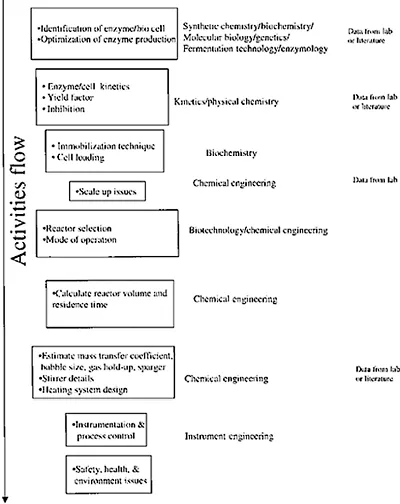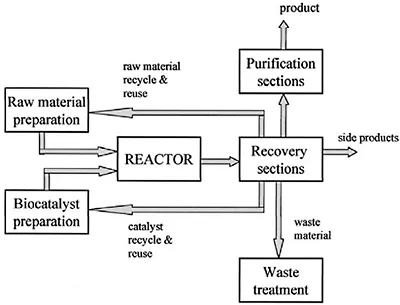
eBook - ePub
Biotransformations and Bioprocesses
Mukesh Doble, Anil Kumar Kruthiventi, Vilas Ganjanan Gaikar, Mukesh Doble, Anil Kumar Kruthiventi, Vilas Ganjanan Gaikar
This is a test
Share book
- 406 pages
- English
- ePUB (mobile friendly)
- Available on iOS & Android
eBook - ePub
Biotransformations and Bioprocesses
Mukesh Doble, Anil Kumar Kruthiventi, Vilas Ganjanan Gaikar, Mukesh Doble, Anil Kumar Kruthiventi, Vilas Ganjanan Gaikar
Book details
Book preview
Table of contents
Citations
About This Book
From the laboratory to full-scale commercial production, this reference provides a clear and in-depth analysis of bioreactor design and operation and encompasses critical aspects of the biocatalytic manufacturing process. It clarifies principles in reaction and biochemical engineering, synthetic and biotransformation chemistry, and biocell and enzy
Frequently asked questions
How do I cancel my subscription?
Can/how do I download books?
At the moment all of our mobile-responsive ePub books are available to download via the app. Most of our PDFs are also available to download and we're working on making the final remaining ones downloadable now. Learn more here.
What is the difference between the pricing plans?
Both plans give you full access to the library and all of Perlego’s features. The only differences are the price and subscription period: With the annual plan you’ll save around 30% compared to 12 months on the monthly plan.
What is Perlego?
We are an online textbook subscription service, where you can get access to an entire online library for less than the price of a single book per month. With over 1 million books across 1000+ topics, we’ve got you covered! Learn more here.
Do you support text-to-speech?
Look out for the read-aloud symbol on your next book to see if you can listen to it. The read-aloud tool reads text aloud for you, highlighting the text as it is being read. You can pause it, speed it up and slow it down. Learn more here.
Is Biotransformations and Bioprocesses an online PDF/ePUB?
Yes, you can access Biotransformations and Bioprocesses by Mukesh Doble, Anil Kumar Kruthiventi, Vilas Ganjanan Gaikar, Mukesh Doble, Anil Kumar Kruthiventi, Vilas Ganjanan Gaikar in PDF and/or ePUB format, as well as other popular books in Medicina & Farmacologia. We have over one million books available in our catalogue for you to explore.
Information
1
Introduction and Overview
Biotransformation deals with use of natural and recombinant microorganisms (e.g., yeast, fungi, bacteria), enzymes, whole cells, etc., as catalysts in organic synthesis. Biotransformation plays a key role in the area of foodstuff, chiral drug industry, vitamins, specialty chemicals, and animal feed stock (Fig. 1.1). Scaling up a bioprocess from the lab to a commercial scale is challenging and needs several innovations. Nevertheless, more and more industries are moving toward developing processes based on biocatalysis because of their inherent advantages. In the year 2000 biotechnology stocks traded in the Nasdaq exchange outperformed the overall index by 24% (outperformed the Internet stocks by 17%)! This observed general buoyancy is due to the successful applications of biotransformations in the field of pharmaceuticals, environmental bioremediation, textiles, plastics, and agriculture. Biopolymers made from dextrose and plastics made from corn sugar beet and other biomass compete with polymers made from hydrocarbons. Breakthroughs in the area of optimization, reactor design, separation techniques, and molecular modeling are a few of the underlying reasons for these successes.
The design and operation of industrial reactors for bioprocesses are inherently different from the conventional reactors. This book deals not only with how a biocatalyst could be used for synthesis of an organic molecule but also with the steps involved in the scale-up of a process from the bench scale to the full commercial scale and the reaction engineering aspects of the manufacturing technology, with an in-depth analysis of bioreactor design.

FIGURE 1.1 Role of biotransformation.
As shown in Fig. 1.2 the field of biotransformation and biopro
cess is interdisciplinary in nature. As the process moves from the lab scale to full-scale commercial production, it requires the expertise of biochemist, molecular biologist, synthetic chemist, physical chemist, biotechnologist, and chemical and instrument engineers. All the aspects listed in Fig. 1.2 are dealt in the various chapters of this book. At times the process as it is scaled up may have to go back to the lab because of issues not foreseen earlier.
A biochemical process generally consists of five sections; they are catalyst and raw material preparation, reaction, biocell recovery for reuse or destruction, product recovery and purification, and waste disposal (Fig. 1.3). The book is divided into four parts. The first part deals with the fundamentals, namely chemistry of biotransformation and the associated areas such as synthetic chemistry, enzyme chemistry, frontiers in biotransformations, and enzyme and biocell kinetics. The second part deals with bioreactors selection, types of bioreactors and their design including fermentors, and aspects of biochemical engineering. The third part touches on the downstream separation techniques, and the fourth part, on industrial examples of biotransformations, waste treatment, and scale-up of bioreactions.
The book is written for practicing biochemists and pharmacists who would like to understand the reaction engineering aspects and to chemical engineers who wish to understand the synthetic techniques and organic chem istry aspects of this vast field. A large number of problems are given in the end of many of the chapters for students to sharpen their knowledge they would have acquired. This book is not intended to be an encyclopedia for biotransformations or bioreactors, but a ready reference to the practioners relating the science and engineering.

FIGURE 1.2 Biocatalysis and bioprocess: an interdisciplinary field.

FIGURE 1.3 General flow sheet of a biocatalytic manufacturing process.
Chapter 2 gives an introduction to molecules, structures and their relationships, quantum mechanical approach, and different types of reactions starting from small to supra molecules. This explanation is then extended to enzymes and proteins.
Chapter 3 describes the structure and activity of enzymes and proteins, differences between enzymes and conventional heterogeneous catalysts and the thermodynamic aspects of the biocatalytic reaction.
Chapter 4 deals in detail with the reactions catalyzed by enzymes, whole cells, and microbes. Mechanistic aspects of these reactions are also discussed.
Chapter 5 deals with various experimental techniques and analytical techniques a bioorganic chemist will employ in the lab. These techniques are very specific to biocatalytic reactions.
Chapter 6 briefly describes the frontier research areas in the area of biotransformation that includes cross-linked enzymes, designer enzymes, ab-zymes, site-selective modification of enzymes, etc., all aimed toward improving their stability, activity, and specificity.
Chapter 7 deals with enzyme kinetics, inhibition, Michaleis-Menten approach to modeling biocatalytic reactions, and cell growth. Rate equation for different types of reactions is listed.
Chapter 8 deals with biochemical reactor selection, different types of reactor and their salient features. Basic design equations for various types of reactors and Monod equation are also described here.
Chapter 9 deals with fermentation, namely fermentation classification, issues in fermentation, modeling of molds, and four stages of biocell growth. Details of reactor and process control design are also described here.
Chapter 10 gives an overview of reaction engineering principles such as mass and heat transfers and how they are estimated for design purposes.
Chapter 11 deals with stirred bioreactors in detail, since they are used in general because of simple construction and ease of operation. Several correlations for gas-liquid mass transfer that are needed for design are described here.
Chapter 12 gives a detailed analysis of tower bioreactors including the gas, solid, and liquid mixing and heat transfer issues.
Chapter 13 is an introduction to biochemical separation and down-stream processing and purification. The various traditional chemical engineering separation processes such as distillation, extraction, filtration, etc., and separations that are very specific to biochemical processes, namely, chromatography, membrane, electrophoresis, etc. are discussed here.
Chapter 14 deals with industrial examples of where biocatalyst is used successfully including chiral synthesis, pharmaceuticals, specialty chemicals, etc. This chapter is an eye opener to chemists and biologists, giving the industrial world scenario.
Chapter 15 deals with in situ and ex situ waste treatment procedures for solid, liquid, and gas. Different types of reactors used in waste treatment are also discussed. The current chemical methods available in waste treatment are also listed with their advantages and disadvantages over the biochemical approach.
Chapter 16 deals with a large number of scale-up rules which need to be followed for successfully translating a process from bench to commercial scale. They relate to mixing, heat transfer, solid suspension, etc. Several scale-up rules are listed depending upon the criteria one would like to select. A list of innovative techniques reported in literature for scaling up biochemical processes is also tabulated.
2
Chemical Bonding, Structure, and Reaction Dynamics
2.1 INTRODUCTION TO CHEMISTRY
Our unquenchable curiosity about our environs and ourselves is at the root of all the scientific endeavors. We marvel at the way the wings of the butterfly are colored, at the fine smell of a jasmine flower, at the gigantic colossus of the Sal tree trunks, and the list goes on endless. All of this myriad variety, we call nature, and in fact our own body is an eternal source of wonder and joy, involving intricate mechanisms (transformations) at the atomic, molecular, supramolecular, and the gross levels. Our journey begins, when we try to understand and imitate this infinite variety. How does all this happen? What are its components? Why is it happening only this way and not by any other way? These are some of the queries, that drive us to explore, analyze, understand, and know.
2.1.1 Origins of Organic Chemistry
As one of the tools that fostered an increased understanding of our world, the science of Chemistry—“the study of matter and the changes they undergo at a molecular level”— developed until near the end of eighteenth century. Initially, there was a single branch, but later with the continued studies of Lavoiser, Berzelius, Wohler, and others the three major branches were recognized. One branch was concerned with the matter obtained from natural or living sources and was called organic chemistry. Jons Jacob Berzelius coined this term. The other branch dealt with substances derived from nonliving matter— minerals and the like—it was called inorganic chemistry. The dynamic aspects of the changes that occur in both of these compounds had to explained in a more methodical mathematical language and thus started physical chemistry. Combustion analysis established that organic chemistry is the study of carbon compounds.
Apart, from the water content almost all of the material, except for some trace minerals in living systems, is made up of organic compounds. The food that we take, the fragrances we inhale, the colors we see, the medicines we partake are predominantly organic compounds.
If we had not had a coating of dipalmitoyl phosphatidyl choline (DPPC) molecules in the lining of our alveoli in our lungs, it would not have been possible for us to breath. These help in maintaining the flexibility of the alveoli.
With the advances in spectroscopic instrumentation and femtosecond laser techniques, organic chemistry has developed into a mature science, and its influence is felt in various other branches of science. A casual look at any modern biology texts or journals makes it amply clear that a good fundamental understanding of the principles of organic chemistry is essential to appreciate those sciences and also to better the advances in them.
During the last decade computational chemistry has joined modern instrumental and chromatographic metho...